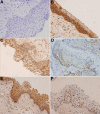E-cadherin promoter hypermethylation may contribute to protein inactivation in pterygia
- PMID: 20596253
- PMCID: PMC2893054
E-cadherin promoter hypermethylation may contribute to protein inactivation in pterygia
Abstract
Purpose: Our recent reports indicated that the molecular changes of pterygia are similar to tumor cells. We believe that pterygia may have a similar mechanism in oncogenesis. Many studies have revealed that E-cadherin associated protein expression decreases in many tumors and pterygia. E-cadherin may be a marker for both tumor metastasis and prognosis. However, no studies have examined the reason for E-cadherin protein inactivation in pterygia. Therefore, this study aimed to analyze the association of E-cadherin promoter hypermethylation with protein inactivation in pterygial tissues.
Methods: E-cadherin methylation-status and the expression of E-cadherin and beta-catenin protein were studied using methylation-specific PCR and immunohistochemistry, respectively, on 120 pterygial specimens and 30 normal conjunctivas.
Results: Hypermethylation of E-cadherin gene promoter was detected in 32 (26.7%) of the 120 pterygial specimens. A total of 79 (65.8%) pterygial specimens tested positive for E-cadherin protein expression and 41 (34.2%) specimens tested negative. The E-cadherin staining was limited to the membrane of the epithelial layer. There was a reverse correlation between E-cadherin gene promoter hypermethylation and E-cadherin protein expression (p<0.0001). Aberrant localization of beta-catenin was higher in the E-cadherin negative group than in E-cadherin positive group.
Conclusions: Our study demonstrates E-cadherin gene promoter hypermethylation were associated with low or absent expression of E-cadherin. Moreover, loss of E-cadherin protein may contribute to aberrant localization of beta-catenin. These data provide evidence that methylation exists in pterygia and may play a role in their development.
Figures

Similar articles
-
CyclinD1 protein expressed in pterygia is associated with β-catenin protein localization.Mol Vis. 2010 Dec 15;16:2733-8. Mol Vis. 2010. PMID: 21179427 Free PMC article.
-
Hypermethylation of the p16 gene promoter in pterygia and its association with the expression of DNA methyltransferase 3b.Mol Vis. 2006 Nov 17;12:1411-6. Mol Vis. 2006. PMID: 17149367
-
Epigenetic inactivation of the E-cadherin gene in eyelid sebaceous gland carcinoma.Br J Dermatol. 2012 Sep;167(3):583-90. doi: 10.1111/j.1365-2133.2012.10968.x. Epub 2012 Jul 19. Br J Dermatol. 2012. PMID: 22458737
-
[Effects of CDH1 gene promoter methylation on expression of E-cadherin and beta-catenin and its clinicopathological significance in colon carcinoma].Zhonghua Wei Chang Wai Ke Za Zhi. 2011 Jul;14(7):538-41. Zhonghua Wei Chang Wai Ke Za Zhi. 2011. PMID: 21792768 Chinese.
-
[Detection of gene promoter methylation and mRNA, protein expression levels of E-cadherin in nasopharyngeal carcinoma].Zhonghua Bing Li Xue Za Zhi. 2003 Feb;32(1):25-30. Zhonghua Bing Li Xue Za Zhi. 2003. PMID: 12760799 Chinese.
Cited by
-
Altered expression of β-catenin, E-cadherin, and E-cadherin promoter methylation in epithelial ovarian carcinoma.Tumour Biol. 2013 Aug;34(4):2459-68. doi: 10.1007/s13277-013-0797-9. Epub 2013 Apr 19. Tumour Biol. 2013. PMID: 23605324
-
Evaluation of LATS1 and LATS2 Promoter Methylation with the Risk of Pterygium Formation.J Ophthalmol. 2016;2016:5431021. doi: 10.1155/2016/5431021. Epub 2016 Jan 28. J Ophthalmol. 2016. PMID: 26942001 Free PMC article.
-
CyclinD1 protein expressed in pterygia is associated with β-catenin protein localization.Mol Vis. 2010 Dec 15;16:2733-8. Mol Vis. 2010. PMID: 21179427 Free PMC article.
-
Histone H3 lysine 9 tri-methylation is associated with pterygium.BMC Ophthalmol. 2025 Mar 3;25(1):106. doi: 10.1186/s12886-025-03939-7. BMC Ophthalmol. 2025. PMID: 40033254 Free PMC article.
References
-
- Tan DT, Lim AS, Goh HS, Smith DR. Abnormal expression of the p53 tumor suppressor gene in the conjunctiva of patients with pterygium. Am J Ophthalmol. 1997;123:404–5. - PubMed
-
- Dushku N, Reid TW. P53 expression in altered limbal basal cells of pingula, pterygia, and limbal tumors. Curr Eye Res. 1997;16:1179–92. - PubMed
-
- Onur C, Orhan D, Orhan M, Dizbay Sak S, Tulunay O, Irkeç M. Expression of p53 protein in pterygia. Eur J Ophthalmol. 1998;8:157–61. - PubMed
-
- Livni N, Ilsar M, Frucht-Pery J, Chowers I, Pe’er J, Zamir E. Proliferative activity and p53 expression in primary and recurrent pterygia. Ophthalmology. 2001;108:985–8. - PubMed
-
- Weinstein O, Rosenthal G, Zirkin H, Monos T, Lifshitz T, Argov S. Overexpression of p53 tumor suppressor gene in pterygia. Eye. 2002;16:619–21. - PubMed
Publication types
MeSH terms
Substances
LinkOut - more resources
Full Text Sources
